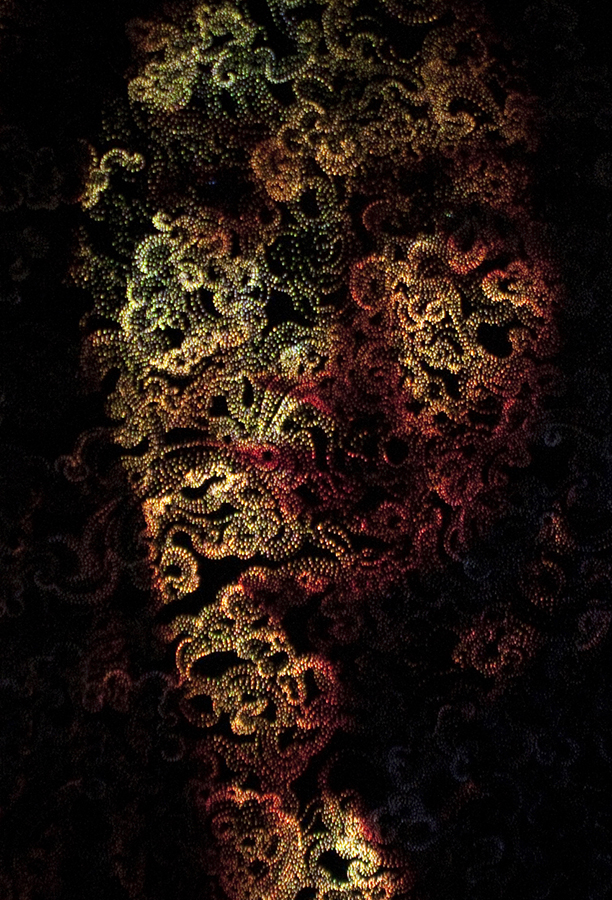
Environmental Composition 2012 #3
Environmental Composition 2012 #3 is created with Light Point Drawings on black wrap with video projections. Black wrap is matte-finished studio aluminum foil used to control and reduce spill light. With a gauge 25 needle (0.02025 nominal outer diameter), I perforated the black wrap to create elaborate curvilinear patterns that are inspired by the shape of incense smoke. Incense smoke is a vapor; it does not have a solid physical body and its form is infinitely variable.
Most of my work came into being not through logical deduction but more from a revelatory discovery during early experimentation. In 2008, one day I was resting after hours of working and experimenting with a number of video devices. I turned my head to face the video projector on the floor, which was connected to a VHS video deck. At that moment I became totally attracted by the beautifully choreographed moving light from the video projector and gazed at it for a very long time in a completely transfixed state. Of course, focusing on the projector was very harsh and abrasive for the eyes. However, as one looks at the projector one cannot recognize the image it projects but can only see the moving and transient patterns of light. These transient patterns revealed to me that this perception corresponds to a Buddhist understanding of reality, which advocates the illusory nature of subject-object duality, sees all apparently opposite concepts, which in Korean are gong (emptiness, transcendental reality) and saek (matter, perceived reality), intrinsically as one. I wanted to create a work that utilizes projection light itself but does not project an image, and started experimenting with different objects that could cancel the representational quality of projection and could allow the viewer to confront a profound light source.
Around that time I was diagnosed as glaucoma-suspect, an incurable eye disease that can permanently damage vision. I was totally crushed and felt absolutely hopeless. It seemed that there was no meaning to go on in life if I would have to give up being an artist. However, I tried to find a way to continue to create visual work without seeing it, and a way to use my other senses to perceive my work. I discovered that when I puncture the black wrap with a needle, I could read the image with my hands as if they were braille points.
The motif of the patterns in these works grew out of the organic curvilinear shapes that Marian Zazeela had developed in her drawings from the early ‘70s. When the Light Point Drawing is stretched out on a horizontal flat surface, the drawing is almost indistinguishable and is like invisible braille points. I was not able to see the whole composition while I was working on the drawing and had to rely on the intelligence of my hand to create the patterns.
When light strikes one surface of the long scroll of the Light Point Drawing, only the light that has passed through the needle holes is visible from the other side. As the light from the projection passes through the needle holes, the video image loses its representational properties and can be seen merely as colored light. The drawings are viewed as indiscernibly moving light from the video projection glowing through the needle hole patterns, creating an abstract and analogous representation of Manifest Unmanifest.
Copyright © Jung Hee Choi 2009 – 2012